
MT306-501
User’s Guide
400-0637-001
2
5. Operation
5.1 Control
The MT306-501 has many advanced remote control capabilities
when used in the MultiTasker enclosure. These capabilities are
accessible through standard RS232 or TCP/IP communication.
The actual controlling can be accomplished through a computer
control system or any other device capable of sending
commands.
5.1.1 RS232/TCP Interface
This section lists all the RS232/TCP control and configuration
command formats and their ranges.
The TCP/IP ports have the following default settings:
IP address ... 192.168.10.84
Port.............. 23
The rear panel RS232 port has the following settings:
Baud ............ 115k
Data bits ...... 8
Stop bits ...... 1
Parity ........... None
Flow ............. None
5.1.2 Command Basics
The control commands for the MT306-501 are in a simple ASCII
character format.
1. Square brackets "[ ]" are part of the command.
2. Use uppercase letters for all commands.
3. Spaces are NOT legal characters.
4. Do NOT send carriage returns or line feeds;
these are invalid characters.
A command that instructs the card only to perform an action will
generate feedback of "[
Card ID
]". The open bracket followed by
the card ID and then a close bracket indicates the card received
and executed a valid command. If the command requested
information from the card, the feedback generated by the card is
the acknowledgement of having received a valid command.
[C04]
Card C4 (slot 4) executed a valid command
Invalid commands generate feedback that includes "ER" and may
also include an error code.
[ERC04]
Card C4 (slot 4) failed to execute a command
Check command syntax.
Check values sent are within a valid range.
Commands ending in "S" will be saved into memory. Commands
not ending in "S" are executed, but not restored at reset or power
up.
5.1.3 Conventions Used in this Manual
Card IDs:
In this manual, cards are referenced by their card ID which is
equivalent to their slot number:
C1, C2, C3, C4 ... C20
Group IDs:
Groups are referenced by their group ID:
G1, G2, G3 ... G8
5.2 Description of Commands
Each command consists of three parts: Function, Card ID, and
Save.
[ Function , Card ID Save]
Example: [VERC4]
VER
= Function
C4
= Card ID or Group ID
S
= Save this setting (optional)
The card ID is a unique identifier, equal to the enclosure slot
number. As the slot number, the value can range from 1 to 20
depending on the enclosure.
The group ID is a number representing a group of cards defined
with the [GROUP] command. When using the group ID, all cards
in the group perform the same instruction.
Changing the position of a card significantly affects the
commands recorded on software definitions or third-party control
systems.

























